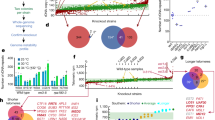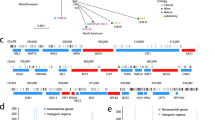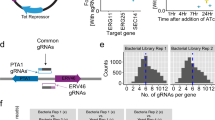Abstract
Conditional temperature-sensitive (ts) mutations are valuable reagents for studying essential genes in the yeast Saccharomyces cerevisiae. We constructed 787 ts strains, covering 497 (∼45%) of the 1,101 essential yeast genes, with ∼30% of the genes represented by multiple alleles. All of the alleles are integrated into their native genomic locus in the S288C common reference strain and are linked to a kanMX selectable marker, allowing further genetic manipulation by synthetic genetic array (SGA)–based, high-throughput methods. We show two such manipulations: barcoding of 440 strains, which enables chemical-genetic suppression analysis, and the construction of arrays of strains carrying different fluorescent markers of subcellular structure, which enables quantitative analysis of phenotypes using high-content screening. Quantitative analysis of a GFP-tubulin marker identified roles for cohesin and condensin genes in spindle disassembly. This mutant collection should facilitate a wide range of systematic studies aimed at understanding the functions of essential genes.
This is a preview of subscription content, access via your institution
Access options
Subscribe to this journal
Receive 12 print issues and online access
$209.00 per year
only $17.42 per issue
Buy this article
- Purchase on Springer Link
- Instant access to full article PDF
Prices may be subject to local taxes which are calculated during checkout




Similar content being viewed by others
References
Giaever, G. et al. Functional profiling of the Saccharomyces cerevisiae genome. Nature 418, 387–391 (2002).
Kim, D.U. et al. Analysis of a genome-wide set of gene deletions in the fission yeast Schizosaccharomyces pombe. Nat. Biotechnol. 28, 617–623 (2010).
Hughes, T.R. Yeast and drug discovery. Funct. Integr. Genomics 2, 199–211 (2002).
Moir, D., Stewart, S.E., Osmond, B.C. & Botstein, D. Cold-sensitive cell-division-cycle mutants of yeast: isolation, properties, and pseudoreversion studies. Genetics 100, 547–563 (1982).
Kanemaki, M., Sanchez-Diaz, A., Gambus, A. & Labib, K. Functional proteomic identification of DNA replication proteins by induced proteolysis in vivo. Nature 423, 720–724 (2003).
Mnaimneh, S. et al. Exploration of essential gene functions via titratable promoter alleles. Cell 118, 31–44 (2004).
Schuldiner, M. et al. Exploration of the function and organization of the yeast early secretory pathway through an epistatic miniarray profile. Cell 123, 507–519 (2005).
Ben-Aroya, S. et al. Toward a comprehensive temperature-sensitive mutant repository of the essential genes of Saccharomyces cerevisiae. Mol. Cell 30, 248–258 (2008).
Brachmann, C.B. et al. Designer deletion strains derived from Saccharomyces cerevisiae S288C: a useful set of strains and plasmids for PCR-mediated gene disruption and other applications. Yeast 14, 115–132 (1998).
Ho, C.H. et al. A molecular barcoded yeast ORF library enables mode-of-action analysis of bioactive compounds. Nat. Biotechnol. 27, 369–377 (2009).
Jones, G.M. et al. A systematic library for comprehensive overexpression screens in Saccharomyces cerevisiae. Nat. Methods 5, 239–241 (2008).
Giaever, G. et al. Chemogenomic profiling: identifying the functional interactions of small molecules in yeast. Proc. Natl. Acad. Sci. USA 101, 793–798 (2004).
Hillenmeyer, M.E. et al. The chemical genomic portrait of yeast: uncovering a phenotype for all genes. Science 320, 362–365 (2008).
Shoemaker, D.D., Lashkari, D.A., Morris, D., Mittmann, M. & Davis, R.W. Quantitative phenotypic analysis of yeast deletion mutants using a highly parallel molecular bar-coding strategy. Nat. Genet. 14, 450–456 (1996).
Smith, A.M. et al. Quantitative phenotyping via deep barcode sequencing. Genome Res. 19, 1836–1842 (2009).
Pierce, S.E., Davis, R.W., Nislow, C. & Giaever, G. Genome-wide analysis of barcoded Saccharomyces cerevisiae gene-deletion mutants in pooled cultures. Nat. Protoc. 2, 2958–2974 (2007).
Yan, Z. et al. Yeast Barcoders: a chemogenomic application of a universal donor-strain collection carrying bar-code identifiers. Nat. Methods 5, 719–725 (2008).
Baxter, A. et al. Squalestatin 1, a potent inhibitor of squalene synthase, which lowers serum cholesterol in vivo. J. Biol. Chem. 267, 11705–11708 (1992).
Bergstrom, J.D. et al. Zaragozic acids: a family of fungal metabolites that are picomolar competitive inhibitors of squalene synthase. Proc. Natl. Acad. Sci. USA 90, 80–84 (1993).
Charlton-Menys, V. & Durrington, P.N. Human cholesterol metabolism and therapeutic molecules. Exp. Physiol. 93, 27–42 (2008).
Vizeacoumar, F.J. et al. Integrating high-throughput genetic interaction mapping and high-content screening to explore yeast spindle morphogenesis. J. Cell Biol. 188, 69–81 (2010).
Buvelot, S., Tatsutani, S.Y., Vermaak, D. & Biggins, S. The budding yeast Ipl1/Aurora protein kinase regulates mitotic spindle disassembly. J. Cell Biol. 160, 329–339 (2003).
Pereira, G. & Schiebel, E. Separase regulates INCENP-Aurora B anaphase spindle function through Cdc14. Science 302, 2120–2124 (2003).
Ruchaud, S., Carmena, M. & Earnshaw, W.C. The chromosomal passenger complex: one for all and all for one. Cell 131, 230–231 (2007).
Sullivan, M., Lehane, C. & Uhlmann, F. Orchestrating anaphase and mitotic exit: separase cleavage and localization of Slk19. Nat. Cell Biol. 3, 771–777 (2001).
Zeng, X. et al. Slk19p is a centromere protein that functions to stabilize mitotic spindles. J. Cell Biol. 146, 415–425 (1999).
Huang, C.E., Milutinovich, M. & Koshland, D. Rings, bracelet or snaps: fashionable alternatives for Smc complexes. Phil. Trans. R. Soc. Lond. B 360, 537–542 (2005).
Nasmyth, K. & Haering, C.H. The structure and function of SMC and kleisin complexes. Annu. Rev. Biochem. 74, 595–648 (2005).
Guacci, V., Koshland, D. & Strunnikov, A. A direct link between sister chromatid cohesion and chromosome condensation revealed through the analysis of MCD1 in S. cerevisiae. Cell 91, 47–57 (1997).
Straight, A.F., Sedat, J.W. & Murray, A.W. Time-lapse microscopy reveals unique roles for kinesins during anaphase in budding yeast. J. Cell Biol. 143, 687–694 (1998).
Yeh, E. et al. Pericentric chromatin is organized into an intramolecular loop in mitosis. Curr. Biol. 18, 81–90 (2008).
Khmelinskii, A., Lawrence, C., Roostalu, J. & Schiebel, E. Cdc14-regulated midzone assembly controls anaphase B. J. Cell Biol. 177, 981–993 (2007).
Fridman, V., Gerson-Gurwitz, A., Movshovich, N., Kupiec, M. & Gheber, L. Midzone organization restricts interpolar microtubule plus-end dynamics during spindle elongation. EMBO Rep. 10, 387–393 (2009).
Schuyler, S.C., Liu, J.Y. & Pellman, D. The molecular function of Ase1p: evidence for a MAP-dependent midzone-specific spindle matrix. Microtubule-associated proteins. J. Cell Biol. 160, 517–528 (2003).
Pinsky, B.A. & Biggins, S. The spindle checkpoint: tension versus attachment. Trends Cell Biol. 15, 486–493 (2005).
Stern, B.M. & Murray, A.W. Lack of tension at kinetochores activates the spindle checkpoint in budding yeast. Curr. Biol. 11, 1462–1467 (2001).
Mirchenko, L. & Uhlmann, F. Sli15(INCENP) Dephosphorylation prevents mitotic checkpoint reengagement due to loss of tension at anaphase onset. Curr. Biol. 20, 1396–1401 (2010).
Bachellier-Bassi, S., Gadal, O., Bourout, G. & Nehrbass, U. Cell cycle-dependent kinetochore localization of condensin complex in Saccharomyces cerevisiae. J. Struct. Biol. 162, 248–259 (2008).
Freeman, L., Aragon-Alcaide, L. & Strunnikov, A. The condensin complex governs chromosome condensation and mitotic transmission of rDNA. J. Cell Biol. 149, 811–824 (2000).
Lavoie, B.D., Hogan, E. & Koshland, D. In vivo requirements for rDNA chromosome condensation reveal two cell-cycle-regulated pathways for mitotic chromosome folding. Genes Dev. 18, 76–87 (2004).
Costanzo, M. et al. The genetic landscape of a cell. Science 327, 425–431 (2010).
Amberg, D.C., Basart, E. & Botstein, D. Defining protein interactions with yeast actin in vivo. Nat. Struct. Biol. 2, 28–35 (1995).
Dreze, M. et al. 'Edgetic' perturbation of a C. elegans BCL2 ortholog. Nat. Methods 6, 843–849 (2009).
Dimster-Denk, D. et al. Comprehensive evaluation of isoprenoid biosynthesis regulation in Saccharomyces cerevisiae utilizing the Genome Reporter Matrix. J. Lipid Res. 40, 850–860 (1999).
Kuranda, K., Francois, J. & Palamarczyk, G. The isoprenoid pathway and transcriptional response to its inhibitors in the yeast Saccharomyces cerevisiae. FEM. Yeast Res. 10, 14–27 (2010).
Song, J.L., Lyons, C.N., Holleman, S., Oliver, B.G. & White, T.C. Antifungal activity of fluconazole in combination with lovastatin and their effects on gene expression in the ergosterol and prenylation pathways in Candida albicans. Med. Mycol. 41, 417–425 (2003).
Tong, A.H. & Boone, C. Synthetic genetic array analysis in Saccharomyces cerevisiae. Methods Mol. Biol. 313, 171–192 (2006).
Warringer, J., Anevski, D., Liu, B. & Blomberg, A. Chemogenetic fingerprinting by analysis of cellular growth dynamics. BMC Chem. Biol. 8, 3 (2008).
Warringer, J., Ericson, E., Fernandez, L., Nerman, O. & Blomberg, A. High-resolution yeast phenomics resolves different physiological features in the saline response. Proc. Natl. Acad. Sci. USA 100, 15724–15729 (2003).
Lee, W. et al. Genome-wide requirements for resistance to functionally distinct DNA-damaging agents. PLoS Genet. 1, e24 (2005).
St. Onge, R.P. et al. Systematic pathway analysis using high-resolution fitness profiling of combinatorial gene deletions. Nat. Genet. 39, 199–206 (2007).
Costanzo, M. & Boone, C. SGAM: an array-based approach for high-resolution genetic mapping in Saccharomyces cerevisiae. Methods Mol. Biol. 548, 37–53 (2009).
Baryshnikova, A. et al. Synthetic genetic array (SGA) analysis in Saccharomyces cerevisiae and Schizosaccharomyces pombe. Methods Enzymol. 470, 145–179 (2010).
Vizeacoumar, F.J., Chong, Y., Boone, C. & Andrews, B.J. A picture is worth a thousand words: genomics to phenomics in the yeast Saccharomyces cerevisiae. FEBS Lett. 583, 1656–1661 (2009).
Holland, J. Adaptation in Natural and Artificial Systems: an Introductory Analysis with Applications to Biology, Control, and Artificial Intelligence. (University of Michigan Press, Ann Arbor, 1975).
Gingras, A.C. et al. A novel, evolutionarily conserved protein phosphatase complex involved in cisplatin sensitivity. Mol. Cell. Proteomics 4, 1725–1740 (2005).
Breitkreutz, A. et al. A global protein kinase and phosphatase interaction network in yeast. Science 328, 1043–1046 (2010).
Perkins, D.N., Pappin, D.J., Creasy, D.M. & Cottrell, J.S. Probability-based protein identification by searching sequence databases using mass spectrometry data. Electrophoresis 20, 3551–3567 (1999).
Acknowledgements
We thank the members of the Boone, Andrews and Bloom laboratory for their input and discussions. We thank S. Biggins (Fred Hutchinson Cancer Research Center) for her insights on cohesin and condensin components. We thank M. Zackrisson (University of Gothenburg) for statistical support. The Sli15-6A-GFP construct was a gift from E. Schiebel (University of Heidelberg) and the Mad1-NLS construct was a gift from R. Wozniak (University of Alberta). We also thank Jennifer Reginold for manual inspection of HCS images. F.J.V. was supported by a postdoctoral fellowship from the Best Foundation. B.A. and C.B. were supported by Genome Canada through the Ontario Genomics Institute as per research agreement 2004-OGI-3-01 and the Canadian Institutes of Health Research (MOP-97939).
Author information
Authors and Affiliations
Contributions
Z.L., F.J.V., C.B. and B.A. conceived and designed the experiments. Z.L. and S.B. constructed the ts strains. J.W. and A.B. conducted and analyzed liquid growth profiling experiments. Z.L., F.J.V., F.S.V., J.L., R.M., K.J. and Z.Z. generated and analyzed the HCS data. M.C., A.B., B.V., J.B. and C.L.M. generated and analyzed the data. Z.Y.L. and A.C.G. performed mass spectrometry analyses. Z.L., Z.Y., M.D., J.A.F., C.B., G.G. and C.N. performed the chemical genetic experiments. Z.L., F.J.V., A.S., J.H. and K.B. performed the analysis on cohesin and condensin complexes. H.L., Z.Y., S.B., A.D., G.G., C.N., C.B., M.C., F.S.V., A.D., A.G., Z.Z. and K.B. provided technical support/reagents/materials/analysis tools. Z.L., F.J.V., M.C., B.A. and C.B. wrote the paper.
Corresponding authors
Ethics declarations
Competing interests
The authors declare no competing financial interests.
Supplementary information
Supplementary Text and Figures
Supplementary Figs. 1–6 (PDF 10016 kb)
Rights and permissions
About this article
Cite this article
Li, Z., Vizeacoumar, F., Bahr, S. et al. Systematic exploration of essential yeast gene function with temperature-sensitive mutants. Nat Biotechnol 29, 361–367 (2011). https://doi.org/10.1038/nbt.1832
Received:
Accepted:
Published:
Issue Date:
DOI: https://doi.org/10.1038/nbt.1832
This article is cited by
-
Glc7/PP1 dephosphorylates histone H3T11 to regulate autophagy and telomere silencing in response to nutrient availability
Cell Discovery (2023)
-
Orphan quality control by an SCF ubiquitin ligase directed to pervasive C-degrons
Nature Communications (2023)
-
A robust yeast biocontainment system with two-layered regulation switch dependent on unnatural amino acid
Nature Communications (2023)
-
The ER calcium channel Csg2 integrates sphingolipid metabolism with autophagy
Nature Communications (2023)
-
Fit-Seq2.0: An Improved Software for High-Throughput Fitness Measurements Using Pooled Competition Assays
Journal of Molecular Evolution (2023)



